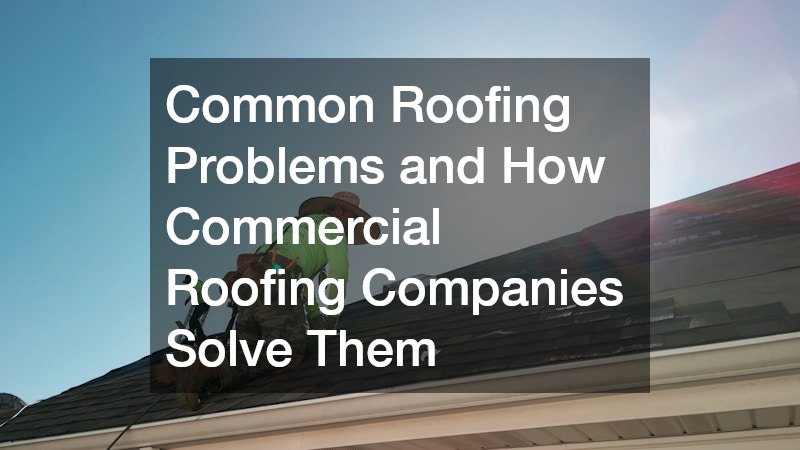The roof is one of the most critical components of any commercial property. It protects the building, its contents, and the people inside from the elements. Yet, like any structure, commercial roofs are prone to problems over time. Weather exposure, material wear, and improper installation can all lead to issues that compromise safety and efficiency. Recognizing common roofing problems early and working with professional commercial roofing companies can save time, money, and headaches.
In this blog, we’ll explore some of the most frequent roofing challenges and explain how experts address them.
Leaks and Water Damage
Leaks are perhaps the most common issue in commercial roofing. Water can penetrate through small cracks, poorly sealed seams, or damaged flashing, leading to structural damage, mold growth, and interior damage. Commercial roofing companies identify the source of leaks using specialized equipment, including moisture meters and infrared cameras. Once the problem is located, they repair damaged areas or replace affected roofing sections. Additionally, they may reinforce vulnerable areas with high-quality sealants or protective coatings to prevent future leaks. Timely intervention minimizes long-term damage and keeps business operations running smoothly.
Ponding Water
Flat or low-slope commercial roofs are particularly susceptible to ponding water—areas where water collects instead of draining properly. Over time, standing water can degrade roofing materials, cause leaks, and even increase structural load. Professional roofing contractors assess the roof’s slope and drainage systems, making adjustments or installing new drains if necessary. They may also apply water-resistant membranes to extend the roof’s life. By addressing ponding water, commercial roofing companies prevent expensive repairs and maintain a safe, functional roof.
Blistering and Bubbling
Blistering occurs when trapped moisture or air beneath the roofing material causes bubbles to form. Bubbling can weaken the roof, making it more prone to leaks and punctures. This problem often arises from improper installation, poor ventilation, or moisture penetration. Experienced commercial roofing specialists carefully remove damaged sections and install replacement materials, ensuring proper adhesion and ventilation to prevent recurrence. By addressing these issues professionally, businesses can avoid structural damage and costly maintenance down the line.
Cracked or Damaged Membranes
Many commercial roofs use membrane materials such as TPO, EPDM, or PVC. These membranes are durable but not immune to cracking, tearing, or degradation over time due to UV exposure, temperature fluctuations, or heavy foot traffic. Commercial roofing companies inspect the membranes regularly, patching minor cracks or replacing damaged sections. Preventive maintenance, including cleaning and applying protective coatings, extends the roof’s lifespan and maintains its protective qualities.
Improper Installation
Some roofing problems stem from the initial installation. Improperly installed flashing, poorly sealed seams, or inadequate underlayment can lead to a host of issues, including leaks, blistering, and material failure. Commercial roofing experts are trained to assess the quality of installation and make corrections as needed. Whether it involves resealing seams, adjusting flashing, or replacing substandard materials, professional intervention ensures the roof meets industry standards and functions as intended.
Roof Deterioration Due to Weather
Commercial roofs are exposed to harsh environmental conditions such as heavy rain, snow, wind, and UV rays. Over time, these factors can deteriorate materials, causing cracking, fading, or rust on metal components. Roofing companies perform routine inspections to identify early signs of weather-related damage. They provide solutions such as applying protective coatings, replacing weathered sections, and reinforcing vulnerable areas. By proactively addressing weather damage, businesses reduce the likelihood of emergency repairs and extend the life of their roofing system.
Structural Issues
Sometimes, the problems go beyond the surface. Roof sagging, uneven surfaces, or visible dips can indicate structural issues in the underlying framework. Commercial roofing contractors evaluate the structural integrity of the roof and recommend solutions, which may include reinforcing beams, replacing damaged decking, or performing complete roof replacements if necessary. Addressing structural problems promptly ensures the safety of building occupants and protects valuable assets inside the facility.
Energy Efficiency Upgrades
In addition to repairs, professional commercial roofing companies can help enhance energy efficiency. Roof coatings, reflective membranes, and insulation upgrades reduce heat absorption and lower energy costs for heating and cooling. Properly installed roofing systems also improve indoor comfort and protect HVAC equipment by minimizing temperature fluctuations. These upgrades are an added benefit of working with experienced commercial roofing professionals.
A well-maintained commercial roof is essential for protecting your business, employees, and property. Common issues such as leaks, ponding water, blistering, membrane damage, and structural problems can quickly escalate if ignored. Partnering with professional commercial roofing companies ensures that problems are accurately diagnosed and effectively repaired, prolonging the life of the roof and preventing costly emergencies.
Routine inspections, preventive maintenance, and expert repairs are critical for long-term roofing performance. By addressing issues promptly and relying on professionals, businesses safeguard their investment, improve energy efficiency, and maintain a safe, comfortable environment for employees and clients. When it comes to commercial roofing, professional expertise makes all the difference.






